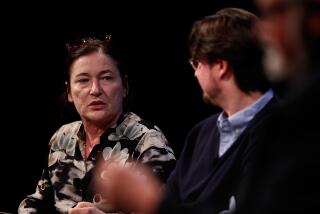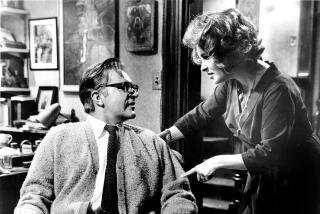A Smudged Portrait of a Sullied Marriage
- Share via
The clever, stylized novel of conceit is among the hardest of fictions to bring off. In such a novel, extremes of behavior, personality, language and plot are not meant to be taken literally; the exaggeration, like the foreshadowing in Mannerist painting, is meant to create a big bold effect, to convey an idea or a feeling that in the Renaissance would have been depicted realistically and in the Medieval period through a code of symbols and motifs. The success of such stylization depends on how willing the reader is to suspend disbelief, how charmed or entertained or educated he is by the exaggeration, and whether he feels that all the narrative flourish has been put to some eventual resonant purpose.
“The Dangerous Husband,” Jane Shapiro’s second novel (following “After Moondog”), begins auspiciously enough, with a first-person voice that is wry and knowing. At a friend’s Thanksgiving, the unnamed narrator, a photographer, meets a man, Dennis, a professor of sociology who has inherited money and has taken a leave of absence to write a novel. In a handful of strokes, Shapiro leads us through the couple’s rapid courtship and marriage. “Secretly we were starved twins, suddenly at the end of our lifelong search for our other halves,” the narrator explains. “We were 40 years old and, now I see, immaculate.”
Immaculate, alas, doesn’t last for long (when does it ever?). There are dark presentiments in the air. Early on, Dennis tells the narrator, “The self is situationally constructed . . . people are not . . . governed by an inner core of values.” She disagrees. “Our values are going to determine what we do. Look . . . here’s something I know. I am not going to kill. I mean unless it was in some extreme self-defense situation . . . believe me, I’m not murdering anybody.” But, as we soon learn, she is murdering somebody--or thinking about it, anyway--and that somebody is her husband. For the remainder of “The Dangerous Husband,” Shapiro basically sets about charting the couple’s transition from the immaculate to the sullied, and from the loving to the vengeful and the murderous.
“As with every love affair we’ve ever heard about in which the lovers are permitted to be together rather than being forcibly separated on account of being the children of rival clans,” the narrator observes, “his other self was a betrayal, and I’m sure mine was to him.” This is the kind of thing Shapiro does best--displaying in one gesture an astuteness about stories, people and relationships--but in a way it is the last example of its kind in the novel. Soon afterward, the narrator stops considering her own participation in the couple’s increasingly odd dynamic; from here on in, the only villain (though he is really too buffoonish to be called that) is Dennis.
Fairly quickly, Dennis’ true, slovenly, “dangerous” self emerges. He becomes disheveled, spilling water over his clothes, tripping over a sofa, spitting crumbs when he talks. And worse: in horseplay, he throws her across the room; in sex, he touches her roughly.
The exaggeration is meant, the reader assumes, to encode and heighten the antipathies and disjunctions that slowly seep into a marriage. The problem is, however, that outside of his messiness and his physical roughness--impediments obviously but hardly qualities worth being murdered for--Dennis seems to be a reasonable, loving, generous-hearted man, whereas the narrator remains almost entirely opaque or reactive. We never understand why she lacks compassion for Dennis’ disturbances and--beyond that--why she allows herself to plot Dennis’ death rather than walk away from their marriage or try to repair it. Despite its moments of dead-on understanding of the small, perhaps inevitable disillusionments that come with intimacy, “The Dangerous Husband” is static in its story, thin in its characterization and wearily repetitive in its ironic, stylized flash.
More to Read
Sign up for our Book Club newsletter
Get the latest news, events and more from the Los Angeles Times Book Club, and help us get L.A. reading and talking.
You may occasionally receive promotional content from the Los Angeles Times.










